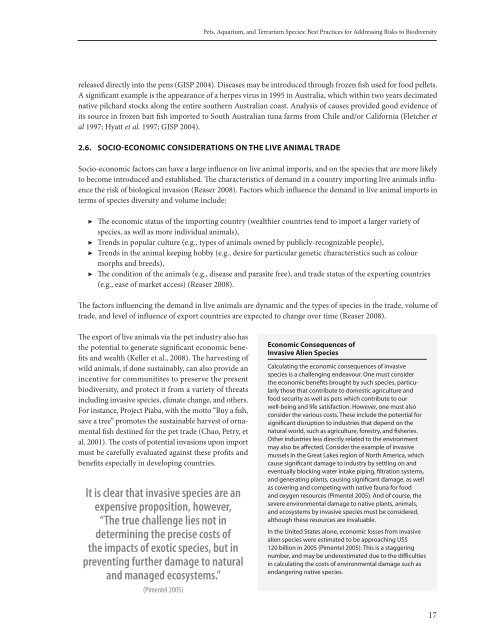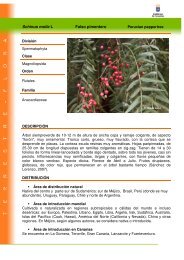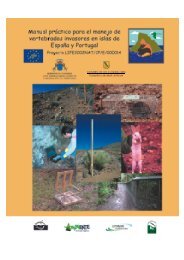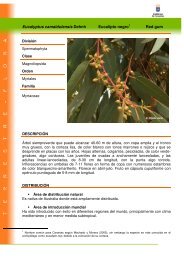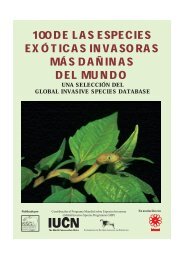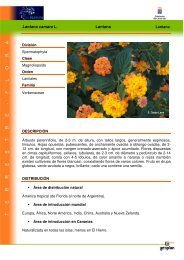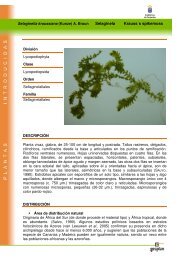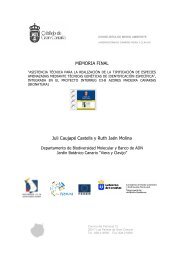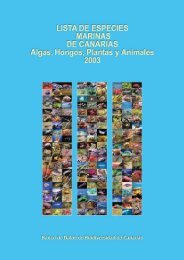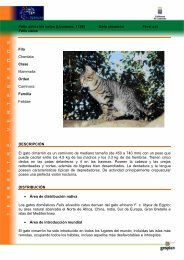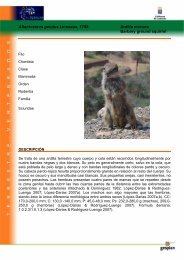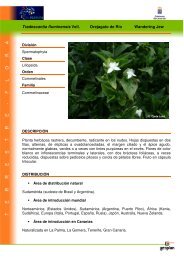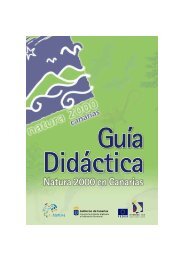Pets, Aquarium, and Terrarium Species - Convention on Biological ...
Pets, Aquarium, and Terrarium Species - Convention on Biological ...
Pets, Aquarium, and Terrarium Species - Convention on Biological ...
You also want an ePaper? Increase the reach of your titles
YUMPU automatically turns print PDFs into web optimized ePapers that Google loves.
<str<strong>on</strong>g>Pets</str<strong>on</strong>g>, <str<strong>on</strong>g>Aquarium</str<strong>on</strong>g>, <str<strong>on</strong>g>and</str<strong>on</strong>g> <str<strong>on</strong>g>Terrarium</str<strong>on</strong>g> <str<strong>on</strong>g>Species</str<strong>on</strong>g>: Best Practices for Addressing Risks to Biodiversity<br />
released directly into the pens (GISP 2004). Diseases may be introduced through frozen fish used for food pellets.<br />
A significant example is the appearance of a herpes virus in 1995 in Australia, which within two years decimated<br />
native pilchard stocks al<strong>on</strong>g the entire southern Australian coast. Analysis of causes provided good evidence of<br />
its source in frozen bait fish imported to South Australian tuna farms from Chile <str<strong>on</strong>g>and</str<strong>on</strong>g>/or California (Fletcher et<br />
al 1997; Hyatt et al. 1997; GISP 2004).<br />
2.6. Socio-Ec<strong>on</strong>omic c<strong>on</strong>siderati<strong>on</strong>s <strong>on</strong> the Live Animal Trade<br />
Socio-ec<strong>on</strong>omic factors can have a large influence <strong>on</strong> live animal imports, <str<strong>on</strong>g>and</str<strong>on</strong>g> <strong>on</strong> the species that are more likely<br />
to become introduced <str<strong>on</strong>g>and</str<strong>on</strong>g> established. The characteristics of dem<str<strong>on</strong>g>and</str<strong>on</strong>g> in a country importing live animals influence<br />
the risk of biological invasi<strong>on</strong> (Reaser 2008). Factors which influence the dem<str<strong>on</strong>g>and</str<strong>on</strong>g> in live animal imports in<br />
terms of species diversity <str<strong>on</strong>g>and</str<strong>on</strong>g> volume include:<br />
▶▶<br />
The ec<strong>on</strong>omic status of the importing country (wealthier countries tend to import a larger variety of<br />
species, as well as more individual animals),<br />
▶▶<br />
Trends in popular culture (e.g., types of animals owned by publicly-recognizable people),<br />
▶▶<br />
Trends in the animal keeping hobby (e.g., desire for particular genetic characteristics such as colour<br />
morphs <str<strong>on</strong>g>and</str<strong>on</strong>g> breeds),<br />
▶▶<br />
The c<strong>on</strong>diti<strong>on</strong> of the animals (e.g., disease <str<strong>on</strong>g>and</str<strong>on</strong>g> parasite free), <str<strong>on</strong>g>and</str<strong>on</strong>g> trade status of the exporting countries<br />
(e.g., ease of market access) (Reaser 2008).<br />
The factors influencing the dem<str<strong>on</strong>g>and</str<strong>on</strong>g> in live animals are dynamic <str<strong>on</strong>g>and</str<strong>on</strong>g> the types of species in the trade, volume of<br />
trade, <str<strong>on</strong>g>and</str<strong>on</strong>g> level of influence of export countries are expected to change over time (Reaser 2008).<br />
The export of live animals via the pet industry also has<br />
the potential to generate significant ec<strong>on</strong>omic benefits<br />
<str<strong>on</strong>g>and</str<strong>on</strong>g> wealth (Keller et al., 2008). The harvesting of<br />
wild animals, if d<strong>on</strong>e sustainably, can also provide an<br />
incentive for communitites to preserve the present<br />
biodiversity, <str<strong>on</strong>g>and</str<strong>on</strong>g> protect it from a variety of threats<br />
including invasive species, climate change, <str<strong>on</strong>g>and</str<strong>on</strong>g> others.<br />
For instance, Project Piaba, with the motto “Buy a fish,<br />
save a tree” promotes the sustainable harvest of ornamental<br />
fish destined for the pet trade (Chao, Petry, et<br />
al. 2001). The costs of potential invasi<strong>on</strong>s up<strong>on</strong> import<br />
must be carefully evaluated against these profits <str<strong>on</strong>g>and</str<strong>on</strong>g><br />
benefits especially in developing countries.<br />
It is clear that invasive species are an<br />
expensive propositi<strong>on</strong>, however,<br />
“The true challenge lies not in<br />
determining the precise costs of<br />
the impacts of exotic species, but in<br />
preventing further damage to natural<br />
<str<strong>on</strong>g>and</str<strong>on</strong>g> managed ecosystems.”<br />
(Pimentel 2005)<br />
Ec<strong>on</strong>omic C<strong>on</strong>sequences of<br />
Invasive Alien <str<strong>on</strong>g>Species</str<strong>on</strong>g><br />
Calculating the ec<strong>on</strong>omic c<strong>on</strong>sequences of invasive<br />
species is a challenging endeavour. One must c<strong>on</strong>sider<br />
the ec<strong>on</strong>omic benefits brought by such species, particularly<br />
those that c<strong>on</strong>tribute to domestic agriculture <str<strong>on</strong>g>and</str<strong>on</strong>g><br />
food security as well as pets which c<strong>on</strong>tribute to our<br />
well-being <str<strong>on</strong>g>and</str<strong>on</strong>g> life satisfacti<strong>on</strong>. However, <strong>on</strong>e must also<br />
c<strong>on</strong>sider the various costs. These include the potential for<br />
significant disrupti<strong>on</strong> to industries that depend <strong>on</strong> the<br />
natural world, such as agriculture, forestry, <str<strong>on</strong>g>and</str<strong>on</strong>g> fisheries.<br />
Other industries less directly related to the envir<strong>on</strong>ment<br />
may also be affected. C<strong>on</strong>sider the example of invasive<br />
mussels in the Great Lakes regi<strong>on</strong> of North America, which<br />
cause significant damage to industry by settling <strong>on</strong> <str<strong>on</strong>g>and</str<strong>on</strong>g><br />
eventually blocking water intake piping, filtrati<strong>on</strong> systems,<br />
<str<strong>on</strong>g>and</str<strong>on</strong>g> generating plants, causing significant damage, as well<br />
as covering <str<strong>on</strong>g>and</str<strong>on</strong>g> competing with native fauna for food<br />
<str<strong>on</strong>g>and</str<strong>on</strong>g> oxygen resources (Pimentel 2005). And of course, the<br />
severe envir<strong>on</strong>mental damage to native plants, animals,<br />
<str<strong>on</strong>g>and</str<strong>on</strong>g> ecosystems by invasive species must be c<strong>on</strong>sidered,<br />
although these resources are invaluable.<br />
In the United States al<strong>on</strong>e, ec<strong>on</strong>omic losses from invasive<br />
alien species were estimated to be approaching US$<br />
120 billi<strong>on</strong> in 2005 (Pimentel 2005). This is a staggering<br />
number, <str<strong>on</strong>g>and</str<strong>on</strong>g> may be underestimated due to the difficulties<br />
in calculating the costs of envir<strong>on</strong>mental damage such as<br />
endangering native species.<br />
17


